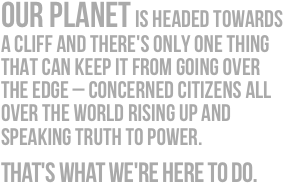-by Virginie
Last Tuesday evening, the Ad Hoc Working Group on Further Commitments (AWG) convened for the 3rd and last time of the Nairobi negotiations. Created under Article 3.9 of the Kyoto Protocol, the AWG was set up in order to discuss further commitments by Annex I parties (industrialized nations) for the post-2012 second commitment period—Since the Kyoto Protocol is to be effective from 2008-2012 (first commitment period), the AWG’s role at this point is to create a framework and timetable capable of guiding such discussion and ensuring that there is no gap year(s) between the first and second commitment period.
Any positive outcome? Well, parties reached a general agreement to move forward, which, being such a time sensitive issue, is a good thing. However, the decision agreed upon by parties unfortunately has little substance. Firstly, the adopted conclusion (decision FCCC/KP/AWG/2006/L.4, for you policy wonkees) fails to include any long-term vision capable of “beefing up” the post-2012 climate regime.
For some time, the EU (supported by other parties) had been pushing for the adoption of “global pathways” that were in line with the International Panel on Climate Change (IPCC) findings: these included ensuring that global atmospheric greenhouse gas (GHG) concentrations stayed below 450 ppm (parts per million) and that we do not allow for a temperature increase above 2 degrees. Unfortunately, the AWG decision merely recognizes the IPCC’s recommendation that :
“global emissions of carbon dioxide have to be reduced to very low levels, well below half of levels in 2000, in order to stabilize their concentrations in the atmosphere” Decision FCCC/KP/AWG/2006/L.4
The AWG conclusion does provide somewhat of a schedule for following meetings but it ultimately fails to provide an end date for the mandate that will formally initiate the crafting of the post-2012 regime. Furthermore, much remains to be discussed as far as what the work plan will look like and how will parties conduct and incorporate the Kyoto protocol review under Article 9 (which is another highly contentious issue. For more info on this, see blog “Going Canadian on Article 9”).
Kyoto the bride
To sum up: lots of words, little meaning, and this is not really getting us anywhere. However, we could say that the dynamic present within the last AWG working groups was indicative of an outcome of the type. Earlier Tuesday, India illustrated its frustration in a rather creative way, comparing the Kyoto process to a traditional wedding where the bride does not show her face until it is time to consume the wedding. India was alluding to Annex I Parties revealing what they are willing to accept and discuss (in terms of future commitments) on the eve of the coming into action of the Kyoto agreement, wishing they “could have known the bride earlier”.
Mixed feelings
Overall, there was a general sense of disappointment amongst the ENGO’s (Environmental Non-Governmental Organizations) while parties did express some contempt for having reached an agreement. Perhaps South Africa as the head of the G77 and China (the developing nations coalition), in congratulating AWG chair Michael Cutajar, best summarized the parties general feeling when noting that: “A good chair is one that makes everyone equally unhappy”.
For a naïve new comer to this process like myself, I can only see that we have missed a tremendous opportunity. Let us hope we catch up at COPMOP3.


